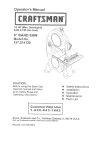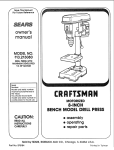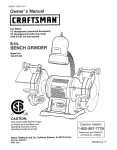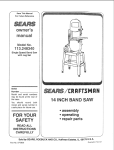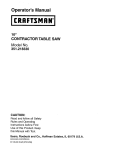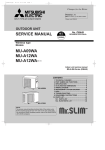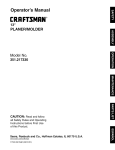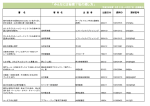Download Craftsman 351.243951 Owner`s manual
Transcript
SAVE THIS MANUAL FOR FUTURE REFERENCE IS_EA/R8 OWNER'S MANUAL MODEL NO. 351.243951 8_A/,_,_/I: RI:1FTSM I:1N ® 18" Band Saw CAUTION: Light Industrial Tool READ ALL INSTRUCTIONS CAREFU LLY! Sold by SEARS, ROEBUCK Part Noo 6666.03 o assembly • operating . repair parts AND CO., Chicago, IL 60684 U.S.A. © April 1993 FULL ONE-YEAR WARRANTY ON SEARS/CRAFTSMAN 18" Band Saw If, within one full year from the date of purchase this Sears Craftsman 18" Band Saw fails due to a defect in material or workmanship, Sears will repair it free of charge. WARRANTY SERVICE 1S AVAILABLE BY SIMPLY RETURNING THE BAND SAW TO THE NEAREST SEARS STORE OR SERVICE CENTER THROUGHOUT THE UNITED STATES. This warranty gives you specific legal rights, and you may have other rights which vary from state to state. SEARS, ROEBUCK AND CO., D/817 WA, 3333 Beverly Road, Hofman Estates, IL 60179 GENERAL SAFETY INSTRUCTIONS BEFORE ANY WORK IS DONE READ THE CAUTIONS LISTED BELOW CAREFULLY. WORKING SAFELY PREVENTS ACCIDENTS. e., Remove adjusting keys and wrenches. Form habit of checking to see that keys and adjusting wrenches are removed before turning on saw_ f Keep all guards in place and in working order. g, Keep all parts in working order. Check to determine that the guard or other parts will operate properly and perform their intended function_ ho Check for damaged parts. Check for alignment of moving parts, binding of moving parts, breakage of parts, mounting and any other condition that may affect a tool's operation. i, A guard or other part that is damaged should be properly repaired or replaced. Do not perform makeshift repairs., (Use the parts list provided with owner's manual to order replacement parts,,) OPERATOR SHOULD KNOW HOW TO USE SAW: OPERATOR SHOULD BE PREPARED FOR JOB: a. b c. d, e f. Wear proper apparel. Do not wear loose clothing, gloves, neckties, rings, bracelets or other jewelry which may get caught in moving parts of the saw, Wear protective hair covering to contain long hair Wear safety shoes with non-slip sole& Wear safety glasses. Everyday glasses have only impact resistant lenses. They are not safety glasses° Wear face mask or dust mask if ct_ing operation is dusty° Be alert and think clearly. Never operate power tools when tired, intoxicated or when taking medications that cause drowsiness,, a WORK AREA SHOULD BE READY FOR JOB: a Keep work area clean. Cluttered work areas and workbenches invite accidents, b, b Do not use power tools in dangerous environments. Do not use power tools in damp or wet location& Do not expose power tools to rain. Work area should be properly lighted, c, The proper electrical outlet should beavailabIefor the logic A three-prong plug should be plugged directly into a properly grounded, three-prong receptacle. Extension cords should have a grounding prong and the three wires of the extension cord should be the correct gauge, Keep visitors a safe distance from work area. e, c d. e f g. d f g Keep children out of workplace° Make workshop childproof,, Use padlocks, master switches and remove starter keys to prevent any unintentional use of power tools h SAW SHOULD BE MAINTAINED: a, Always unplug band saw prior to inspection, b Consult the owner's manual for specific maintaining and adjusting procedures Keep band saw lubricated., Use sharp blades and keep the saw clean for safest operation. c d FOR POWER TOOLS i, j. k I, -2- Use the right tool for the job, Do not force a tool or attachment to do a job for which it was not designed. Disconnect saw from power when changing blade° Avoid accidental start-up. Make surethat the saw is in the "off" position before plugging in, Do not force a tool It wilt work most efficiently at the rate for which it was designed. Use recommended accessories, Consult the owner's manual for recommended accessories. The use of improper accessories may cause risk of injury to persons. Handle the workpiece correctly,, Use push sticks or push blocks when required Protect hands from possible injury° Turn the saw off if it jams. A blade jams when it digs too deeply into the workpiece. (The motor force keeps it stuck in the workplace.) Never leave saw running unattended, Turn the power off and do not leave saw until it comes to a complete stop. Do not overreach. Keep proper footing and balance. Never stand on saw, Serious injury could occur if saw istipped or if blade is unintentionally contacted Keep hands away from moving parts and blade Know your saw. Learn its operation, application and specific limitations. CONTENTS Warranty ............................................. General Safety Instructions for Power Tools .................................. Safety Instructions for Sand Saw ................. Motor and Electrical Specifications ................. Unpacking ....................................... Assembly ............................................. Electrical Connections .......................... Operating Instructions ........................... Maintenance ........................................... Recommended Accessories ........................ Troubleshooting ............................... Parts Illustration and List for Motor' +............... Parts Illustration and List for Switch ................ Parts Illustration for Blade Drive ................... Parts List for Blade Drive .............................. Parts Illustration for Table .......................... Parts List for Table .............................. Parts illustration for Blade Guides ................. Parts List for Blade Guides ...................... 2 2 3 4 4 5 5 5 -9 9 WARNING 9 10 12 13 14 15 16 17 18 19 LABEL This warning label is placed in a specific location so it is The 18" band saw has been marked with a warning label visible to the operator when starting and operating the that needs to be observed for' safe operation, The saw,, operator should be aware of the location and contents of this label. WARNING FOR YOUR OWN SAFETY [] Read and understand owner's manual before [] _ m ] operating band saw _ways wear eye protection Do not wear gloves, neckties, jewelry or loose clothing, Mount saw securely to floor, Maintain proper adjustment of blade tension, [] i Handle workpiece correctly Hold workpiece against table, Use push sticks or push blocks m when required Guards should be in place and used at all times [] Keep fingers out of path of blade [] Turn machine off if it jams. Do not remove jammed or cutoff pieces until the saw is turned off, unplugged and the blade has stopped ]blade guides and thrust bearings Adjust upper guide to just clear workpfeoe, SAFETY INSTRUCTIONS 9, AVOID SHOCKING THE BLADE+ Do not start a cut on a sharp comer',, (See "Blade Pitch." page 7+) I0+ KEEP BAND SAW MAINTAINED, Follow "Maintenance" instructions (page 9) 11+ DISCONNECT POWER Turn switch off and disconnect the powerwhenever band saw is not in use Think safetyl Safety is a combination of operator common sense and alertness at all times when the band saw is being used. WARNING: DO NOT ATTEMPT TO OPERATE THE BAND SAW UNTIL IT IS COMPLETELY ASSEMBLED ACCORDING TO THE INSTRUCTIONS. Caution; 1,+ KNOW GENERAL POWER TOOL SAFETY, Make sure all precautions are understood and provided for (page 2)+ Be certain to follow proper operating procedures despite familiarity gained from frequent use of your band saw+ Always remember that being careless for even a fraction of a second is sufficient time to inflict severe injury. The operation of any power tool can result in foreign objects being thrown into the eyes. which can result in severe eye damage, Always wear safety goggles complying with ANSI Z87+1 (shown on package) before commencing saw operation+ Safety goggles are available at Sears retail or catalog stores 2. SECURE ALL FASTENERS. Frequently check that nuts and bolts are tight and have not vibrated loose 3,. FOLLOW OPERATING INSTRUCTIONS, Operate the band saw as described in the manual, 4+ BE SURE MOTOR RUNS CLOCKWISE facing shaft end+Blade must travel down toward the table+ 5, USE THE CORRECT SPEED. The proper speed will produce the optimum cut 6,. DO NOT FORCE THE CUT+ Slowing or stalling the motor will overheat it+ 7, DO NOT OVERHEAT THE WORKPIECE Excess heat at the cut can damage the blade and reduce the quality of the cut 8 FOR 18" BAND SAW AVOID DEFLECTING THE BLADE, Adjust the blade guides to hold the blade properly, (See "Upper and Lower Blade Guides," pages 6 and 7) -3- MOTOR AND ELECTRICAL Do not remove or alter grounding prong in any manner_ In the event of a malfunction or breakdown, grounding provides a path of least resistance for electrical current to reduce risk of electrical shock. MOTOR The band saw is supplied with a motor° The 120 volt AC capacitor start motor has the following specifications: Max° Developed Horsepower ....................... 2 Voltage .......................................... 120 Amperes Hertz 60 Phase Single RPM ............................................... 1725 Rotation (viewed from shaft end) ........... Clockwise The plug must be plugged into a matching outlet that is properly installed and grounded in accordance'with all local codes and ordinances_ 7 .................................... Do not modify plug provided. If itwitl not fit in the outlet, have the proper outlet installed by a qualified electrician° Improper connection of the equipment-grounding conductor can result in a risk of electrical shock. ........................................ ........... .......................................... SPECIFICATIONS The conductor with insulation having an outer surface which is green or yellow with green stripe is the equipment-grounding conductor,, POWER SOURCE 1_ The motor is designed for operation on the voltage and frequency specified on motor nameplate_ If repair or replacement of the electrical cord or plug is necessary, make sure the equipment-grounding conductor is not connected to a line terminal, 2. Normal loads will be handled safely on voltages not more than 10% above or below nameplate voltage 3. Running unit on voltages which are not within this range may cause overheating and motor burnout. GROUNDING iNSTRUCTIONS WARNING: CHECK WITH A QUALIFIED ELECTRICIAN OR SERVICE PERSONNEL IF GROUNDING INSTRUCTIONS ARE NOT UNDERSTOOD OR IF IN DOUBT AS TO WHETHER BAND SAW IS PROPERLY GROUNDED. DO NOT PERMIT FINGERS TO TOUCH TERMINALS OF PLUGS WHEN INSTALLING OR REMOVING PLUG, EXTENSION CORDS I. The use of any extension cord wilt cause some drop in the voltage and loss of power, 2. Wires of the extension cord must be sufficient in size to carry the current and maintain adequate voltage. 3. Use the table below to determine the minimum wire size (AWoG.) extension cord. 4_ Use only 3-wire extension cords having 3-prong grounding type plugs and 3-pole receptacles which accept the tool plug. 5, If power cord is worn, cut or damaged in any way, have it replaced immediately., Extension Cord Length Wire Size A.W.G, Upto50 ft ........................................... t6 50 - 100 ft ........................................... 14 NOTE: Using extension cords over 100 ft. long is not recommended. The band saw is provided with a 3-conductor cord and ground type plug which has a grounding prong approved by Underwriters Laboratories and the Canadian Standards Association UNPACKING 3. Motor pulley V-belts are shipped cabinet door Check for shipping damage_ tf any damage or loss has occurred, immediately fife a claim with the carrier° behind upper Parts shipped in a separate box within crate: IMPORTANT: TABLE AND RIP FENCE ARE COATED WITH A PROTECTIVE COATING WHICH MUST BE REMOVED FOR PROPER FIT AND OPERATION, 4. 5, 6, 7, 8 Remove coating with mild solvents such as mineral spirits and a soft cloth, Nonflammable solvents are recommended. After cleaning, cover all exposed surfaces with a light coating of oil, Paste ,wax is recommended for table tops Rip fence and rip fence knob 120 Volt plug, 2 each wire nuts, and strain relief 2 Each band saw mounting brackets Motor mount bracket Standard and wide table inserts 9 Miter gauge assembly 10_ Handwheel, handle, 6-1,0 x 8ram set screw and extra long 3mm hex wrench 11_ Hex pin for table 12, 4 Each 5/16-18 x 3/4", 8 each 5/16-18 x 1" and 1 each 5/16_18 x 1 1/8" hex head bolts 13, 20 Each 5/16" and 4 each 8mm flat washers 14 12 Each 5/16" and 4 each 8ram lock washers Caution:Never use highly volatile solvents, Avoid getting cleaning solution on paint, rubber or plastic parts as it may tend to deteriorate these 1inishes, Use soap and water on paint, plastic or rubber components. Band saw comes assembled except for following parts: 1 Table is shipped in a box next to saw 15 4 Each 8mm-1.25 x 25ram hex head bolts 16, 9 Each 5/16"-18 hex nuts 2, Motor is shipped in a box next to saw -4- ASSEMBLY 5 MOUNT MOTOR Refer to Figure 2 NOTE: Do not mount motor pulley to motor until motor is mounted to sawn Refer to Figure 5._ Mount motor (Key No 1) to motor mount bracket (Key No 2) using four each 5/16-18 x 1" he× head bolts (Key NOr, 6), eight each flat washers (Key No. 7) and four each lock washers (Key No, 8), Be sure to mount motor to bracket using holes in motor base as shown in Figure 2 2 Mount motor mount bracket to band saw base using four each 8ram-1,25 x 25mm hex head bolts (Key Noo 3), four each 8ram lock washers (Key No 4) and four' each 8mm flat washers (Key No 5). Refer to Figure 4 6 Mount table using four each 5/16-18 x 3/4" hex head bolts (Key No 12), four each lock washers (Key No, 13) and four eachflatwashers (KeyNo 14). Do not tighten bolts Press the standard insert (Key No. 2) into hole on top of table with beveled slot aligned parallel with slot in table. Position table so that blade is centered with insert slot and blade is parallel with miter gauge slot Secure table by tightening four each 5/16-18 x 3/4" hex head bolts 7 Thread 5/16"_18 hex nut (Key No. 16) onto 5/16-18 x I 1/8" hex head bolt (Key No,_15). Thread bolt into threaded hole on bottom left side of table. Adjust table perpendicular to blade using a square and rotate 5/16-t8 x 1 1/8" bolt so that it holds table in perpendicular position. Rotate hex nut against table to secure bolt, 8 Mount two each mounting brackets (Key No.,24) to holes on front side of band saw base using four each 5/!64 8 × 1"hex head bolts (Key No, 25), eight each flat washers (Key No. 14), four each lock washers (Key No_ 13) and four each 5/16_'-18 hex nuts (Key No 16). Secure mounting brackets to floor using two each anchor bolts (not supplied). ! 3 4 Slide motor pulley (Key NQ 38) onto motor' shaft with motor key in motor' shaft groove and motor pulley groove° Align motor pulley with step pulley (Key No_ 32) using a straight edge so that Vgrooves in motor pulley are aligned with V-grooves in step pulley. Secure motor pulley with two set screws (Key No. 40), Slide belt tension handwheel (Key No..51) onto belt tension shaft (Key No_ 52) and secure handwheel with setscrew (Key No. 55) using 3mm hexwrench Thread handle (Key Nov 53) into handwheeL ELECTRICAL Mount motor V-belt (Key No, 38) on motor pulley and step pulley. Tension V-belts by rotating tension handwheel CON NECTIONS Mount strain relief to motor connection box by removing a "knock-out" on connection box and locking the strain relief through "knock-out" hole with strain relief nut WIRING MOTOR WARNING: ALL ELECTRICAL CONNECTIONS MUST BE PERFORMED BY A QUALIFIED ELECTRICIAN. Refer to Figure 2 Pass motor cord through strain relief and secure cord with screw and nut on strain relief. The motor (Key No, 1) should be wired for 120 volts and clockwise rotation as viewed from shaft end of motor Wire motor with wire nuts provided Be sure to ground motor with green grounding wire in motor cord A schematic supplied with motor will describe proper wiring procedures INSTALL PLUG Refer to Figure 3 Refer to Figure 3 Wire motor tine cord (Key No,. 6) to motor using strain relief (Key No, 8) and two wire nuts (not shown), OPERATING Wire line cord to plug (Key No, 9) provided Be sure to ground plug using green grounding wire in line cord INSTRUCTIONS The 18" Band Saw isa versatile cutting tool and provides four different cutting speeds so the saw can be used to cut a variety of materials. The band saw offers convenient tensioning and tracking so changing blades is not cumbersome The band saw can accommodate blade widths up to 1" for many types of cuts Check to make sure blade is tensioned correctly_ Be sure blade is tracking correctly Align table to blade WARNING: Support workpiece properly Use a smooth steady feed to guide work through cut Choose the proper speed for cutting operation After turning on saw. allow blade to come to full speed before attempting any cutting operation ALWAYS OBSERVE THE FOLLOWING SAFETY PRECAUTIONS. Keep hands away and out of line with moving parts Use proper blade for workpiece. Make sure blade guides are positioned and adjusted correctly Always wear eye protection -5- OPERATING iNSTRUCTiONS If blade tends to ride out of the cabinet, turn knob clockwise to tilt idler wheel up. If blade tends to ride into the cabinet, turn tracking knob counterclockwise to tilt idler wheel down, REMOVING BLADE Refer to Figure 4,. The 18" Band Saw is designed for convenient blade changing. The table is provided with a slot which allows the blade to be removed without disturbing the table. Remove the stud so it will not obstruct removal of blade. When blade is tracking properly, lock the position by holding the knob and tightening the lever (Key No,, 17) against the cabinet. Loosen lever (Key Noo 17) which locks tracking knob (Key No. t6). ALIGNMENT Alignment of drive wheel can be adjusted with hex bolts (Key No, 27), Lock position with nuts (Key No. 28). INSTALLING BLADE NOTE: To replace the blade, the table stud must be removed as described in "Removing Blade" above. Although many of the adjustments may not be altered when the blade is removed, every adjustment should be checked prior to using a newly installed blade, Only attempt adjusting drive wheel alignment if blade cannot be properly tracked with tracking adjustment alone. BLADE GUIDES Refer to Figure & Follow safety precautions which should be observed every time the band saw is turned on, Make sure the blade teeth are pointing in the correct direction. Blade teeth must point down° Turn blade inside out if necessaryH Center the blade on the blade wheel. Tension and track the blade as described in the following sections. Blade guides support the band saw blade at sides and the rear of blade. The blade guides should be adjusted to prevent twisting and deflection of blade, Blade guides should not touch blade when no material or workpiece is in contact with the blade,. Guides need to be adjusted as described below,, UPPER BLADE GUIDES Do not use a new blade to complete a previously started cut, TENSIONING OF DRIVE WHEEL Refer to Figure 4. A blade under high tension may also pull drive wheel out of alignment. Loosen blade tension by rotating handwheel (Key No. 15)o When removing blade be careful because blade may spring from saw when tension is released. The released blade can be removed and replaced with another blade,, NOTE: (Continued) Refer to Figure 6 The upper blade guides employ two ball bearing sets on adjusting pins for side support and a thrust bearing on an adjusting pin at the rear. BLADE Refer to Figure 4. Tension blade by turning the handwheel (Key No. 15). Be sure blade guides are not interfering with the path of the blade. The guide depth bracket (Key No. 26) should be positioned so bearing on either side of blade will support as much of blade width as possible without interfering with the tooth set., Tighten blade until it is properly tensioned, A properly tensioned blade will ring slightly when back of blade is plucked, (Like a string on an instrument ,) Adjust guide depth bracket by loosening bolt (Key No, 11) and sliding bracket into position. NOTE: Secure position of upper guide casting by tightening bolt, Adjust guide bearings to the side of the blade with a hex wrench. CHECK THE TENSION OF A NEW BLADE. ADDITIONAL TENSION MAY BE REQUIRED AFTER A FEW MINUTES OF OPERATION. Use a feeler gauge to check that the bearing is about 0°002" away from the blade Lock the adjustment by tightening the bolt and nut (Key Nos,, 34 and 13). TRACKING BLADE Refer To Figure 6. Track the blade after it has been tensioned° Loosen handle (Key No. 23) and push adjusting pin to set thrust bearings 04002" away from back of the blade, Proper tracking is achieved when drive wheel and idler wheels are aligned, Secure the position of the rear bearing by tightening handle, The knob (Key No, 16) is used to tilt tracking bracket (Key No. 6) and align blade wheels, A change in tension of blade will affect wheel alignment Adjust height of the upper guide bearings to clear the workpiece by 1/4" Loosen knob (Key No, !) and reposition rack within guides, Turn idler wheel (Key No 4) by hand and observe how blade rides on the wheels Tighten knob to secure position on height adjustment -6- OPERATING INSTRUCTIONS LOWER BLADE GUIDES Refer'to Figure 6. The lower blade guide employs two guide blocks for side to side support. The lower guide bracket is spaced close to table surface to minimize unsupported length of blade Loosen nut (Key No, 27) to position the lower guide bracket on the alignment block (Key No. 33). Adjust the lower' guide bracket so the block does not interfere with the blade set. Loosen set screws for' guide blocks and adjust blocks to about 0,002" from each side of blade_ Adjust bearing (Key No. 19) at rear' of blade by loosening the knob (Key NOo32)_ ALIGN TABLE To perform any straight cut accurately, table must be aligned to the blade. Once blade is tensioned and tracked correctly, the tabte can be adjusted to it Lock table in horizontal position_ Attach rip fence to the table and push it against the blade, Make sure rip fence and blade are parallel, If table is not aligned, loosen four hex nuts which attach table to upper trunnion and reposition the table_ Secure table position with four' hex bolts when it is aligned. (Review "Assembly," Number 6,) BLADE SELECTION Blades vary depending on type of material to be cut, size of the workpiece and type of cut that is being performed. Characteristics which make blades different are width, thickness, type of tooth and blade pitch The width of blade describes the distance from tip of a tooth to back of blade Width of blade will affect rigidity of blade. A wider' blade will wander' less and produce a straighter cut Width of blade also limits the smallest radius which can be cut,. A 1/4" wide blade can cut about a 1" diameter_ Blade thickness describes distance between sides of blade, A thicker blade has more rigidity and stronger teetb_ The narrow thick blade would be used to cut curves in metal, while a wide thin blade would be used to re-saw lumber Blade manufacturers should be able to supply information about biades for specific applications (Continued) A blade cuts the work by removing material The blade must scrape a chip of the workpiece away from the cut, The shape of gullet between teeth determines how much material can be taken out with each blade tooth Rake angle is the angle which the cutting face of the tooth makes with a line perpendicular to the back of blade° A 0° rake angle is used to scrape harder materiats away from the cut. A positive rake angle causes the blade to dig aggressively into the workpiece, Softer materials require more aggressive chip removal, Larger gullets provide for faster removaf but have to be limited in size because they make the blade teeth weaker. Blade teeth will also vary in the way which the teeth have been set from one side to the other. A wider set is used for contour work because the wider kerf allows the operator to cut tighter curves, BLADE PITCH Pitch describes number of teeth per inch or tooth size. Blades with more teeth per inch will produce smoother cuts_ The type of material being cut determines number of teeth which should be in contact with wor k, There should always be at least three teeth in contact with the cut to avoid shocking the blade. Blade shocking occurs when the pitch is too large and the blade tooth encounters too much material. This can strip teeth from the blade. When the pitch is too small the gullets of the teeth will fill up, leading to the creation of excess heat for the blade. In soft materials the proper blade has between 6 and 12 teeth per inch. In cutting hard materials, where shocking is more detrimental, there should be between 12 and 24 teeth per'inch. BLADE SPEED The amount of force that the blade cuts with is deter_ mined by blade speed. High cutting speeds are used on soft materials where less force is needed and a high rate of material removal is desired_ Low cutting speeds are used on hard materials where more force is required, To change the blade speed, position the V-belts in the proper configuration as indicated (see Figure 1). Reposition the V-belts and tension them as described in the next section TYPE OF TOOTH The shape of teeth are varied to achieve specific cutting results_ _7- OPERATING iNSTRUCTIONS BLADE SPEED (FPM) 0 700 (Continued) Rip fence is used to guide workpiece to prod uce straight cuts on longer pieces_ Miter gauge is used to produce angle cUtSr 1480 Contour cutting is done by guiding workpiece handed to produce curved shapes, 380_ free* Beveled cutting can be done with any proper work guide method by tilting the table° Regard less ofwhich method of guiding the work is used, a workpiece which overhangs the table by more than 10" should be supported by freestanding material stands RIP FENCE OPERATION Refer to Figure 5_ Rip fence can be used to guide workpiece with one square edge past blade when tabte is aligned properly, Set the rip fence to the desired width of cut on the inside of the throat, Do not forget about the saw kerf. Use a square to measure from tip of a tooth to fence,, Lock fence securely with knob (Key No. 14). The portion of material between blade and fence is considered the workpiece. Material on outside and behind the cut is scrap material which is being cut off, Use right hand to keep work against fence,, Do not push on scrap portion of work, This could pinch or bind blade Avoid passing hands beyond the cut,, Use push sticks to finish cuts and pass the workptece away from the blade. © Figure 1 FPM MITER GAUGE OPERATION 270 - Steel, bronze Use miter gauge for securing and holding workpiece at desired angle to produce angled cuts, Use scale to adjust gauge to desired angle, Caution: Never use miter gauge and rip fence at the same time. Workpiece may bind blade damaging workpiece and injuring operator. 700 - Brass, copper 1480 - Hard woods, plastic 3800 _ Soft woods, other light materials REPOSITIONING V-BELTS Refer to Figures 1 and 4 CONTOUR SAWING The band saw uses a two-belt drive system to provide a selection of blade speeds (see Figure 1)., When contour sawing, both hands must be used to keep workpiece flat against the table and guided along desired path, Avoid positioning hands in line with blade, Hands could contact blade if they slip,, Idler pulley (Key No, 32, Figure 4) is fastened to tension arm (Key No. 33) so both belts can be tensioned at the same time. Position tension arm by revolving handwheel (Key No. 51). Loosen the V-belts by rotating the handwheel counterclockwise Try to stand to front of saw and use hands over portion of table which is to the right of blade and before the cut When the V-belts are loose, position them to desired configuration (see "Blade Speed," and Figure 1) and tighten by rotating the handwheel clockwise, Do not attempt sharp corners which may twist or bind the blade. Cut small corners by sawing around them, Saw to remove smaller pieces of scrap until desired shape is obtained, Belts are properly tensioned when light pressure applied between the pulleys produces about 1/2" deflection. BEVEL CUTTING Do not overtighten V-belts, Excessive tension on V-belts will reduce available cutting force. Refer to Figure 5, Perform any saw operation at a bevel by tilting table Loosen knob (Key No 8, Figure 5) to tilt table to desired position, Use a square or protractor to set angle and lock table in position with knob Use caution when supporting work while bevel cutting Do not allow work to hang on blade. TYPE OF CUT Band saw can be used to perform a variety of cuts Cutting procedure used depends on size and desired shape of cut -8- OPERATING INSTRUCTIONS (Continued) The particles which collect on the drive wheel may affect the band saw's operation. DUST COLLECTION Refer to Figure 4, Sawdust or metal shavings wilt fail into the lower cabinet of the saw. The saw is fitted with a 4" male dust chute (Key No. 45) for attachment to a dust collector° Make sure that the brush (Key Noo 25) is in contact with the wheel to properly remove foreign particles from the drive wheel Caution: Use a dust collector with a 4" diameter hose to create the proper' suction to remove debris from inside the lower cabinet. Check that the lower cabinet is free of sawdust before performing any metal cutting operations. This is a possible fire hazard, MAINTENANCE CLEANING LUBRICATION Keep machine and workshop c_ean, The shielded ball bearings are permanently lubricated when manufactured and require no further' lubrication Do not allow sawdust or metal shavings to accumulate on the band saw. Small amounts of machine oil can be applied to mechanism's threaded or' sliding surfaces. Keep wheels clean, Occasionally apply a coat of automobile type wax to the table to keep it slick and corrosion free,, Debris on wheels wJJ! cause poor" tracking and blade slippage. Keep mechanism's foreign particles, threaded or sliding surfaces free of Operate the band saw with a dust collector to minimize clean up. RECOMMENDED REPLACEMENT , , KEEP BAND SAW IN REPAIR If the power cord is worn or cut in any way, have it replaced, Replace V-belts and blade when they are worn° Replace any damaged or missing part Use the parts list to order'parts. ACCESSORIES (Catalog Items) BLADES FOR L x W" INCH TEETH PER INCH CATALOG NUMBER Wood 133 x 3/4 4 926656 Metal 133 x 3/4 10 926657 Metal 133 x 3/4 14 ,926658 ,,,,,,,, -9- TROUBLESHOOTING SYMPTOM CORRECTIVE Excessive blade breakage Material not secure on table 2o Incorrect speed or feed 1o Squarely place work on table 2 Check Machinist Handbook for recommended speed or feed 3 Check Machinist Handbook for recommended blade type 4. Adjust blade propedy 5. Place blade in contact with work after saw has reached full speed 6 Adjust wheel alignment propedy 7 Adjust blade guides propedy 8 Use thinner blade 9, Replace blade Blade too coarse for material Incorrect blade tension 5, Teeth in contact with work before saw is started 6r, Blade rubs on wheel flange 7. Mis-aligned guides 8 Blade too thick for wheel diameter 9. Cracking at weld 4,_ , ,,,,,Hi, ,,,HU I I ,I,ll,,,I 1, 2. 3_ 4 Use finer tooth blade Try next lower speed Gently increase pressure Reduce speed, increase rate of feed (scale) Change blades (hard spots) 5 Increase rate of feed 6. Remove blade, twist inside out and reinstall blade 7_ Increase tension to proper level 1o Blade too coarse 2., Too much speed 3o Inadequate feed pressure 4, Hard spots or scale in or on material Premature blade dulling 5 Work hardening of material 6 Blade installed backwards 7, Insufficient blade tension ,H, i,i ill, ,i ,i,l,l,i Crooked cuts i i, ,i,l,l,ll, Blade is twisting Unusual wear on side/back of blade Teeth ripping from blade ii , ,ill 1 2. 3. 4, Inadequate blade tension 5 Upper blade guide too far from workpiece 6 Dull blade 7. Speed incorrect 4 5 9., 8o Blade guide assembly toose Blade thrust bearing not adjusted properly 8 9. 1 Too much speed or feed 2, Blade too coarse 1. Reduce speed or feed 2_ Replace with finer blade 6, 7, , Hi Use rip fence; adjust tilt of table at 90° to blade Reduce rate of feed Move both guide blocks within 0.002" to blade (use gauge) Increase blade tension properly Adjust upper guide to clear workpiece by 1/4" Replace blade Check Machinist Handbook for recommended speeds Tighten blade guide assembly Move blade thrust bearing within 0°002" behind blade back H, 1 1. Cut is binding blade i i, 'H'H"'HH""'H Decrease feed pressure H,, 1, Blade guide blocks or bearings worn 2_ Blade guide blocks or bearings not adjusted properly 3, Blade guide blocks or bearing bracket loose 1_ Reptace 2, Adjust as pet"Lower 3 Tighten properly 1, 2. 3. 4. 1. 2, 3 4. Use blade with finer teeth Decrease feed rate Hold workpiece firmly Use blade with coarser teeth 1 2. 3 Reduce tension on blade Reduce tension on drive belt Use blade with finer teeth 4 Use blade with coarser teeth 5 Clean thoroughly; vacuum motor and belt area Teeth too coarse for work Feed too heavy Vibrating workpiece Teeth filling with material i Motor running too hot i Work not square 2_ Rate of feed too great 3. Guide blocks not adjusted properly l,,i, = Rough cuts ACTION(S) ,H,,, H Blade Guides," page 7 ,,i,ll 1. Blade tension too great 2, Drive bett tension too great 3 Blade too coarse for work (typical when cutting pipe) 4, Blade too fine for work (typical when cutting either thick or soft material) 5 Excessive dirt and sawdust -10- SERVICE RECORD DATE MAINTENANCE PERFORMED COMPONENTS ll,_ i ,Ji,,IL,J,,,,,,,,,,,L H ,ll,,,,,,,,ll REQUIRED ii ill ,, REPLACEMENT PARTS ILLUSTRATION FOR MOTOR 1 2 Figure 2 - Motor Illustration REPLACEMENT KEY NO. PART NO, 1 2 6501o00 3 0302°00 4 1333..00 0695.00 STD523110 STD551031 5 6 7 8 9 * 5596o01 PARTS LIST FOR MOTOR DESCRIPTION Motor with key Motor mount bracket QTY. t 1 8-! 25 x 25mm Bolt, hex head 8mm Washer, lock 4 8mm Washer, flat * 5/16-18 x 1" Bolt, hex head 4 4 4 * 5/16" Washer, flat 8 STD551131 * 5/16" Washer, lock 4 STD541031 * 5/16"-18 Nut, hex 4 Standard hardware item available locally. Always order by Part No. not by Key No -12_ REPLACEMENT PARTS ILLUSTRATION FOR SWITCH 11 .1 Figure 3 - Switch illustration REPLACEMENT KEY NO. PART NO, i,,, PARTS LIST FOR SWITCH DESCRIPTION ,,,, Switch with key 1 Switch plate 4-.70 x 10ram Screw, fiat head * 6mm-1o0 Nut, hex 6-1.0 x 16ram Screw, flat head t 4 2 2 5427.00 Line cord (switch to motor) 1 7 8 5428.00 7256.00 Line cord (power to switch) Strain relief 1 2 9 10 5597.00 2820,00 Plug 6ram Washer, serrated t 3 11 12 544200 0582.00 Strain relief Strain relief t 1 • 1 0423,00 2 3 4 5 542&00 5167,00 STD840610 5441.00 6 QTY. " Standard hardware item available locally Always order by Part No, not by Key No, q3- REPLACEMENT PARTS ILLUSTRATION FOR BLADE DRIVE 16 2O 14 t4 17 23 22 18 26 2t 3O 22 37 53 35 51 44 32 5O Figure 4 -t4- REPLACEMENT KEY NO. KEY] PART NO. 1 5101.00 2 0341.00 PARTS LIST FOR BLADE DRIVE QTY. DESCRIP1 Tread 17mm Retatnln_ ring, extema! 2 4 2 1 1 3 4 5 STD315235 5103.00 510&00 * Bearing 6203 Idler wheel Idler shaft 6 7 8 9 t0 510&00 STD852016 5107_00 5108o00 5109.00 Tracking brack, * 16 mm Washer lock 1 16mm x 1_5Nu:, hex Tension bracke Pivot shaft 2 11 1305o00 Push nut, 10mr 12 5t1!.00 13 5112,00 14 15 STD85t008 511&00 Upper wheel s[ pport Spacer 8ram Washer, flat Blade tension handwheel 2 1 1 5 1 NO.I 27 28 29 30 31 32 PART NO. I STD833020 ! STD840610 I 5t23.00 I 5t24_00 l 5125,00 j 512600 DESCRIPTION QTY, * 6-1.0 x 20mm Bolt, hex head * 6mm-l.0 Nut, hex Shaft Drive Wheel V-Belt, 3L610 Idler pulley q t 1 1 33 34 35 36 37 ] 5127,,00 1 512&00 1 5!29,00 1 2809.00 I STD851016 39 40 41 STD3O3340 * V-Belt, 3L340 1 2796.00 Motor pulley 6-1.0 x 12mm Screw, set fL pt I 281&00 I 519600 20mm-1.5, Nut, hex * 6-1o0 x 8ram Screw, set I 104300 42 Tension arm Clevis 8 x 16ram Pin, spring Collar * 16ram Washer, flat 1 J 16 17 18 5114o00 511500 2807.00 19 STD835016 20 7257.00 21 22 23 124 J25 !26 STD852020 5440.00 STD840812 5120.00 512t_00 5!22.00 1 1 Blade tracking knob Tracking lever 8mm-1o25 Nut, hex head washe * 8qo25 x 16mm , hex head Door knob 5 4 2 * 20mm Washer, lock Latch * 8mmq.25 Nut, hex Brush bushing Chip brush 8-1.25 x 100ran , carriage 1 2 2 1 1 1 43 't STD851008 44 t 3837°00 45 I 5!38.00 46 t 280000 47 t 5t40..01 48 1 5141.01 49 t 5t42.00 50t 51 I 52 I 53 ] O I * 8mm Washer', fiat Bearing 6203 RSR Dust chute 4-0°7 x 6ram Screw, set Lower cabinet door Upper' cabinet door Spacer 5598.00 736800 277&00 Cabinet Handwheel Shaft Handle £ 26656 Blade, 133"-4 hook (wood) t 4 ! 1 1 1 4 I i i 1 1 1 1 I t I i 1 Not economical for reptacemenL e Not shown. The accessories are current and were available in the catalog at the time this manual was printed. * Standard hardware item, available locally Always order by Part No not by Key No -15- REPLACEMENT PARTS ILLUSTRATION d 2 _3 18 14 / 24 Figure 5 --16 i FOR TABLE REPLACEMENT ......KEY NO. 1 2 3 4 PARTS LIST FOR TABLE PART NO. 535900 517&00 5195.00 5185.01 DESCRIPTION ................ Table Table insert, thin slot Table insert, wide slot Upper trunnion QTY. 1 1 1 1 5 6 7 8 5187+01 5184.00 5! 8600 STD851008 Lower' trunnion 8-1.25 x 50ram Bolt, carriage Guide block * 8mm Washer, fiat 1 t t 1 9 10 11 12 5210+00 5188,00 2807.00 STD523107 Lock knob 8-1+25x 20mm Bolt, carriage 8mm-1.25 Nut, hex hdL washer * 5/16-18 x 3/4" Bolt, hex head 1 4 4 4 13 14 15 16 STD551131 STD551031 6542.00 STD541031 r* 5/16" Washer, lock * 5/16" Washer, flat 5/16-18 x 1 1/8" Bolt, hex head E* 5/16"-18 Nut, hex 17 18 19 2O 0211 +00 7634.+00 7635+00 5351.00 21 22 23 24 25 0003+00 5356+00 5358+00 5354.00 STD523110 6666.03 , ,, .,,,,,,,,,,,v,, , ,,, o ,, 8 12 t 5 ,, ,,_,,,,,u,,,,, 1 1 1 1 Table stud Scale Screw, thread forming Rip fence Knob, external threads Eye bolt 12mm-1o75 Nut, hex nylon Mountinq bracket * 5/16q8 x 1" Bolt, hex head Owner's Manual 1 1 1 2 4 1 Standard hardware item available locally Not shown Always order by Part No not by Key No REPLACEMENT PARTS LIST FOR MITER GAUGE KEY NO. 1 2 3 4 PART NO. 8251+00 8250.00 1370.00 STD551025 Miter gauge Miter gauge bar #10 Fiber washer * 1/4" Washer, flat 5 6 7 8 9 10 11 12 13 14 15 16 17 825500 8252+00 STD541010 STD511007 8253.00 8254.00 388800 STD511002 599100 1833.00 109300 825600 825700 Threaded pin Knob * #10-24 Hex nut * #10-24 x 3/4" Screw, pan head indicator Scale #10 Washer, fiat * #10-24 x 1/4" Screw, pan head #10-24 x 1/2" Screw, flat head 5-80 x 8mm Screw, fiat head Guide Indexing pin Miter gauge assembly * e Figure 5a DESCRIPTION Standard hardware item available locally Not shown Always order by Part No not by Key No -17- QTY. 1 1 1 1 1 1 3 3 1 1 1 ! 2 1 1 1 1 REPLACEMENT PARTS ILLUSTRATION FOR BLADE GUIDES • 27 28 11 32 34 22 13 14 Figure 6 -18- REPLACEMENT PARTS LIST FOR BLADE GUIDES KEY NO, PART NO. DESCRIPTION QTY , ,,,, ,,,, 1 2 3 4 5 521&00 7258.00 0832,00 7260700 2810.00 Lock knob 10ram Washer 8mmq.25 Nut, hex Blade guide handwheel Pinion gear ........... 1 4 1 t 1 6 7 8 9 10 5! 48.00 5211.00 5212o00 5151,.00 5152.00 8mm Retaining ring, external Bolt plate Guide extrusion Guide bracket Pinion bracket 1 1 1 2 1 1t 12 13 14 15 STD833025 5213.00 STD840610 STD833012 5154.00 * 6-140 x 25mm Bolt, hex head 5mm x 16 Screw, thread forming * 6-1.0mm Nut, hex * 6-1.0 x 12mm Bolt, hex head 6-1.0 × 20mm Screw, flat head 16 17 18 19 2O STD851006 5155°00 3646°00 STD315465 2818.00 * 6mm Washer', flat Upper guide casting Guide bearing pin * Guide bearing (626Z) 6mm-l,0 Nut, hex head washer 21 22 23 24 25 5159.00 516Q.00 5161_00 5162.00 7261.00 26 27 28 29 3O 5164,00 5153,00 STD851006 2819.00 5t66.00 Guide depth bracket 6-1,0mm Nut, hex nylon * 6ram Washer, flat 6q.0 x 12ram Screw, flat po#lt set Lower' guide casting 31 32 33 34 35 36 37 38 39 40 365&00 5169.00 5168.00 STD833020 STD851004 STD833016 STD840407 5156.00 7636.00 0781.00 Guide block Thrust bearing lock knob Alignment block * 6-1,0 x 20mrn Bolt, hex head * 4mm Washer, flat * 6-1,0 x 15mm Bolt, hex head * 4mm-.70 NUt, hex 4ram Washer, serrated Blade guard clip 4-.70 x 8mm Screw, pan head 41 42 43 44 45 5215o00 5216o00 7637_00 5188°00 2811.00 4mm-o70 x 20 Screw, pan head Rack Blade Guard 8mm-1,25 x 20 Bolt, carriage Pinion shaft 6 2 1 t 1 46 47 2817.00 7262.00 4 x 20ram Pin, spring 8mm Washer, flat t 1 , ,,,,,, 2 2 2 2 1 ,,,,,,,,, Guide Thrust Clamp Thrust 4 1 3 3 6 bearing clamp bearing assembly handle bearing clamp 2 1 1 t Guide attaching bracket t Always order by Part No. not by Key No. -t9- t 4 2 2 1 2 1 1 4 _, 6 2 2 1 6 18" Band Saw Light Industrial Tool OWNER'S MANUAL SERVICE Thank you for purchasing your 18" Band Saw from Sears This unit will provide you with many years of reIiable service Should the need exist for repair parts or service, simply contact any Sears Service Center and most Sears, Roebuck and Co stores Be sure to provide ail pertinent facts when you call or visit. The model number of your 18" Band Saw will be found on the upper cabinet door MODEL NO. 351.243951 HOW TO ORDER REPAIR PARTS All parts listed may be ordered from any Sears Service Center and most Sears stores. If the parts you need are not stocked locally, your order wilt be electronically transmitted to the Sears Repair Parts Distribution Center for handling When ordering information: repair parts, always give the following NAME OF ITEM: t8" Band Saw MODEL NUMBER: 351 243951 PART NUMBER: PART DESCRIPTION: Sold by SEARS, Part No. 6666.03 ROEBUCK AND CO., Chicago, IL 60684 UoS,A. © April 1993




















